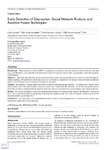Mostrar o rexistro simple do ítem
Early Detection of Depression: Social Network Analysis and Random Forest Techniques
| dc.contributor.author | Cacheda, Fidel | |
| dc.contributor.author | Fernández, Diego | |
| dc.contributor.author | Nóvoa, Francisco | |
| dc.contributor.author | Carneiro, Víctor | |
| dc.date.accessioned | 2019-07-01T15:40:13Z | |
| dc.date.available | 2019-07-01T15:40:13Z | |
| dc.date.issued | 2019-06-10 | |
| dc.identifier.citation | Cacheda F, Fernandez D, Novoa FJ, Carneiro V Early Detection of Depression: Social Network Analysis and Random Forest Techniques J Med Internet Res 2019;21(6):e12554 URL: https://www.jmir.org/2019/6/e12554 DOI: 10.2196/12554 PMID: 31199323 | es_ES |
| dc.identifier.issn | 1438-8871 | |
| dc.identifier.other | PMID: 31199323 | |
| dc.identifier.uri | http://hdl.handle.net/2183/23328 | |
| dc.description.abstract | [Abstract] Background: Major depressive disorder (MDD) or depression is among the most prevalent psychiatric disorders, affecting more than 300 million people globally. Early detection is critical for rapid intervention, which can potentially reduce the escalation of the disorder. Objective: This study used data from social media networks to explore various methods of early detection of MDDs based on machine learning. We performed a thorough analysis of the dataset to characterize the subjects’ behavior based on different aspects of their writings: textual spreading, time gap, and time span. Methods: We proposed 2 different approaches based on machine learning singleton and dual. The former uses 1 random forest (RF) classifier with 2 threshold functions, whereas the latter uses 2 independent RF classifiers, one to detect depressed subjects and another to identify nondepressed individuals. In both cases, features are defined from textual, semantic, and writing similarities. Results: The evaluation follows a time-aware approach that rewards early detections and penalizes late detections. The results show how a dual model performs significantly better than the singleton model and is able to improve current state-of-the-art detection models by more than 10%. Conclusions: Given the results, we consider that this study can help in the development of new solutions to deal with the early detection of depression on social networks. | es_ES |
| dc.description.sponsorship | Ministerio de Economía y Competitividad; TIN2015-70648-P | es_ES |
| dc.description.sponsorship | Xunta de Galicia; ED431G/01 2016-2019 | es_ES |
| dc.language.iso | eng | es_ES |
| dc.publisher | J M I R Publications, Inc. | es_ES |
| dc.relation.uri | https://www.jmir.org/2019/6/e12554/ | es_ES |
| dc.rights | Atribución 3.0 España | es_ES |
| dc.rights.uri | http://creativecommons.org/licenses/by/3.0/es/ | * |
| dc.subject | Depression | es_ES |
| dc.subject | Major depressive disorder | es_ES |
| dc.subject | Social media | es_ES |
| dc.subject | Artificial intelligence | es_ES |
| dc.subject | Machine learning | es_ES |
| dc.title | Early Detection of Depression: Social Network Analysis and Random Forest Techniques | es_ES |
| dc.type | info:eu-repo/semantics/article | es_ES |
| dc.rights.access | info:eu-repo/semantics/openAccess | es_ES |
| UDC.journalTitle | Journal of Medical Internet Research | es_ES |
| UDC.volume | 21 | es_ES |
| UDC.issue | 6 | es_ES |
| dc.identifier.doi | 10.2196/12554 |






